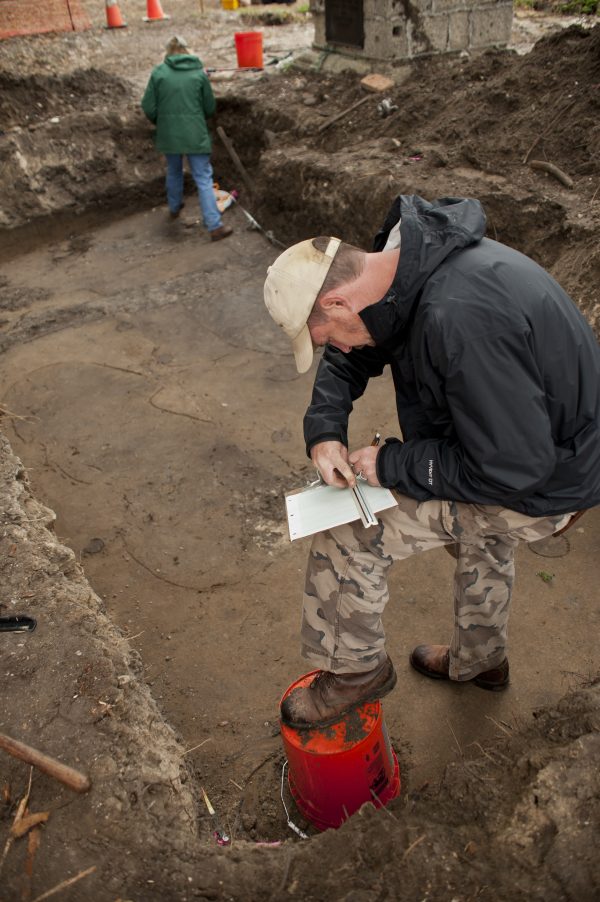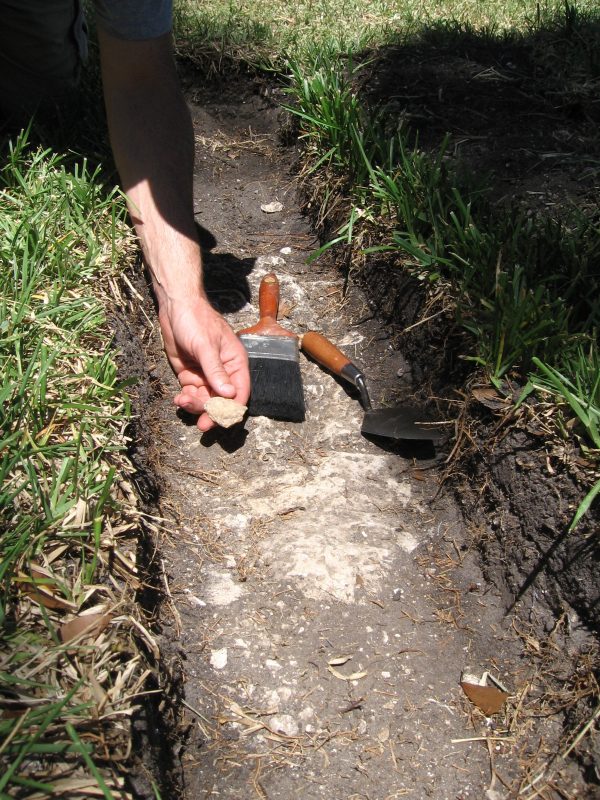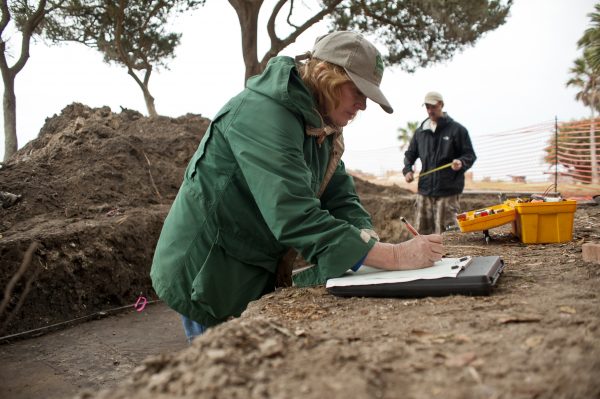
Photo by Kristen Grace
Ask many Americans what they know about early colonial America, and Disney’s “Pocahontas” will probably enter the conversation.
Although the classic cartoon may help children connect with nature, it popularizes the misconception that Jamestown, Virginia, was the first permanent European settlement in America. Florida Museum of Natural History archaeologists are hoping to change what Americans know about its early history – before the English arrived in Jamestown the Spanish had colonized St. Augustine, Florida.
“The goal is to provide a different vision for American history to most of the country, to show that in fact Jamestown wasn’t the only early place here,” said Kathleen Deagan, Florida Museum distinguished professor emeritus in archaeology. “People came to St. Augustine 72 years before Jamestown, with a determination to make a permanent settlement. They built a city and stayed here.”
As the 450thanniversary of St. Augustine approaches in 2015, researchers hope the nation’s first permanent European settlement on the coast of northeast Florida will get the attention it deserves.
Over the last few years, Florida Museum archaeologists have made a determined push to excavate the city’s earliest historical sites, and their discoveries paint a clearer picture of life during St. Augustine’s early years following its foundation in 1565.

Photo by Courtney Boren
In May 2011, Deagan and Florida Museum historical archaeology collection manager Gifford Waters unearthed foundations of one of the largest churches in colonial Spanish Florida and the only mission church made of stone. Marked by coquina stone and tabby foundations, the approximately 90-by-40-foot-structure was uncovered on the site of the first Franciscan mission in Florida, Nombre de Dios. The area boasts the longest-enduring mission in the Southeast, in operation from 1587 until 1763, and the 300-year-old building may predate the famous Castillo de San Marcos fort.
“To find the remains of the first stone structure built in St. Augustine is pretty incredible,” Waters said. “This is the first time we have conducted excavations in that portion of the site, so we’re getting a look at an undocumented area.”
The Mission of Nombre de Dios is located about a quarter of a mile north of the Castillo de San Marco, the fort built on the city’s coast to defend Spain’s claim to the New World in the late-17th century, and the discovery is thought to be a long-lost church commissioned by Florida’s governor in 1677, Deagan said. Owned by the Catholic Diocese of St. Augustine, the church was constructed in honor of the Shrine of Nuestra Señora de La Leche and Buen Parto (Our Lady of the Milk and Safe Delivery), which was erected in the 1650s. After English raiders destroyed the church in 1728, the ruins were gradually buried and the location forgotten.
“This is a long-lost, major building that has been found,” Deagan said. “For its time, it would’ve been one of the biggest ones in Florida.”
Mapping the first settlement

Photo by Kristen Grace
Archaeologists study first-hand accounts of the Spanish conquest of Florida to develop models for mapping buildings in the field, Deagan said.
“It was like getting a 1,000-piece crossword puzzle, but you didn’t have any picture of what it was supposed to be,” Deagan said.
At the Fountain of Youth site, a stone’s throw from Nombre de Dios, researchers have discovered structures believed to be barracks and storage buildings. The site measures about 300-by-300 feet, with marsh and beach on three sides.
“The landscape has changed so much, there could be parts of forts and things out in that little lagoon,” Deagan said.
On July 28, 1565, Don Pedro Menéndez de Avilés set sail from Spain to “La Florida,” reaching Cape Canaveral on Aug. 25. The area was home to the Timucuan Indians. Researchers are unsure if the Indians lived with the settlers or fled, but documentary evidence shows the Spaniards abandoned the first settlement and moved across the bay to Anastasia Island nine months later, possibly because of hostility from the Timucuans, Deagan said.
Some archaeological evidence remains intact, such as beads, uniform buttons, ceramics and rusted iron, but researchers are mainly looking for wood stains in the soil that mark the outer walls of buildings.
“The first thing we do is some lo-tech shovel testing and surveying, and on the basis of that, you can see areas of the site that are critical,” Deagan said. “Then we can go to ground-penetrating radar or conductivity to see areas where there are anomalies.”
In 2012, Deagan and Waters visited the Fountain of Youth site during construction on a monument near the edge of the bay. It turns out, the statue was built in the 1930s on top of the spot researchers believe marks the end of a fortification wall from the Menéndez encampment.
With the ground uncovered for the first time since the monument’s construction 80 years ago, researchers were able to trace the wall’s foundation 220 feet around the encampment.
“We had found over the years a piece here, a piece there of the wall, but didn’t know what it was, we thought it was just a dip in the soil when we would find a stain in one of the corners of the units that didn’t seem to match anything else we had recorded,” Deagan said. “After a couple of those, we predicted a line where a wall should be, then tested all along that line and found it.”
Although scientists had assumed the area contained a fortification wall, actually finding it confirms the historical significance of the Fountain of Youth site, Deagan said.
“It’s really great for us to be able to say, ‘yes, there was a fortification,’ ” Deagan said. “That confirms that the site was the first 1565 settlement of Pedro Menéndez.
Retelling history
Florida Museum researchers are currently developing a public exhibit, “First Colony: Our Spanish Origins,” that brings to life the story of the first Spanish settlement from 1565 to 1763.
The display will explore how people and policies changed over the two centuries of the first Spanish occupation of Florida. The lifestyle will be captured with artifact displays and an interactive video tour though reconstruction of the initial settlement.
Waters said he is particularly excited about the interactive children’s component featured in “First Colony.”
“We’re going to have modern toys accompanied with pictures of toys we found from the 1600s and 1700s,” Waters said. “We want kids to take today and relate it to the past.”
A signature exhibit, which is a smaller preview of “First Colony: Our Spanish Origins,” is currently on display in St. Augustine. The full exhibit is scheduled to open in fall 2013 and travel to the Florida Museum of Natural History in Gainesville in fall 2015.
“We’re hopefully going to teach people how we go through the process of archaeology,” Waters said. “The exhibit will have major interactive elements that both adults and children will enjoy.”
Both Deagan and Waters plan to continue seeking opportunities to excavate the archaeological sites in St. Augustine.
Earlier in 2012, Waters was elected to the Historic St. Augustine Research Institute, which will allow him to apply for small grants to help fund continued excavations, Waters said. Deagan is also a research associate in the institute.
“Being elected is credit to the work that I’ve done there and what I’m continuing to work on,” said Waters, who focused his master’s thesis and Ph.D. dissertation on St. Augustine sites. “I plan on continuing to work on the 18th-century settlements in St. Augustine, but first I want to go back and investigate the large stone church we uncovered last year and try to figure out a more accurate date and periods of construction of that building, as well as research what was going on in that area in the mission grounds.”
Learn more about the Historical Archaeology Collection at the Florida Museum.